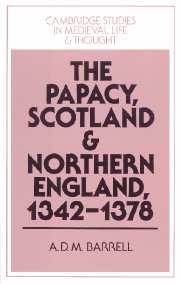Book contents
- Frontmatter
- Contents
- Preface
- Note on currencies
- List of abbreviations
- Map 1 Northern England: dioceses, collegiate churches and major peculiar jurisdictions in the fourteenth century
- Map 2 Northern England, showing some of the more significant places mentioned in the text
- Map 3 Scotland: dioceses and archdeaconries in the fourteenth century
- Map 4 Scotland, showing some of the more significant places mentioned in the text
- Introduction
- 1 Papal taxation and its collection
- 2 Papal provisions
- 3 Opposition to the Papacy
- 4 Judicial aspects of the Papacy
- 5 The Papacy and the bishops
- 6 The Papacy and the regulars
- 7 Papal licences, dispensations and favours
- Conclusion
- Bibliography
- Index
- Titles in the series
1 - Papal taxation and its collection
Published online by Cambridge University Press: 05 May 2010
- Frontmatter
- Contents
- Preface
- Note on currencies
- List of abbreviations
- Map 1 Northern England: dioceses, collegiate churches and major peculiar jurisdictions in the fourteenth century
- Map 2 Northern England, showing some of the more significant places mentioned in the text
- Map 3 Scotland: dioceses and archdeaconries in the fourteenth century
- Map 4 Scotland, showing some of the more significant places mentioned in the text
- Introduction
- 1 Papal taxation and its collection
- 2 Papal provisions
- 3 Opposition to the Papacy
- 4 Judicial aspects of the Papacy
- 5 The Papacy and the bishops
- 6 The Papacy and the regulars
- 7 Papal licences, dispensations and favours
- Conclusion
- Bibliography
- Index
- Titles in the series
Summary
In the centralisation of the papal administration at Avignon, the question of finance naturally loomed large. An elaborate bureaucracy was expensive; so too were the ambitious and ill-starred schemes for a fresh crusade and the confused warfare in the Papal States which was one of the chief causes of the Papacy's long absence from Italy. By being beyond the Alps, the Papacy was deprived of most of its traditional sources of income from its Italian lands; and this, coupled with the ever-increasing cost of the papal court and its governmental machinery, forced the Avignon popes to extend and refine the taxes imposed by their predecessors.
By the middle of the fourteenth century the western church had come to be divided into collectorates, each presided over by a papal collector appointed by the pope or his chamberlain (camerarius) and responsible to the curia's financial arm, the Camera. Until the 1340s the British Isles, including Ireland, usually constituted a single collectorate, but from 1345 Scotland had a collector of its own, and in 1368 Ireland was accorded similar status. These changes represent no more than an admission of political reality. It could no longer be claimed that Scotland was subject to England, and the Scots were more likely to oppose the work of a principal collector established in London than one based locally, while Ireland's political chaos made the work of collection unusually difficult there.
- Type
- Chapter
- Information
- The Papacy, Scotland and Northern England, 1342–1378 , pp. 13 - 78Publisher: Cambridge University PressPrint publication year: 1995

